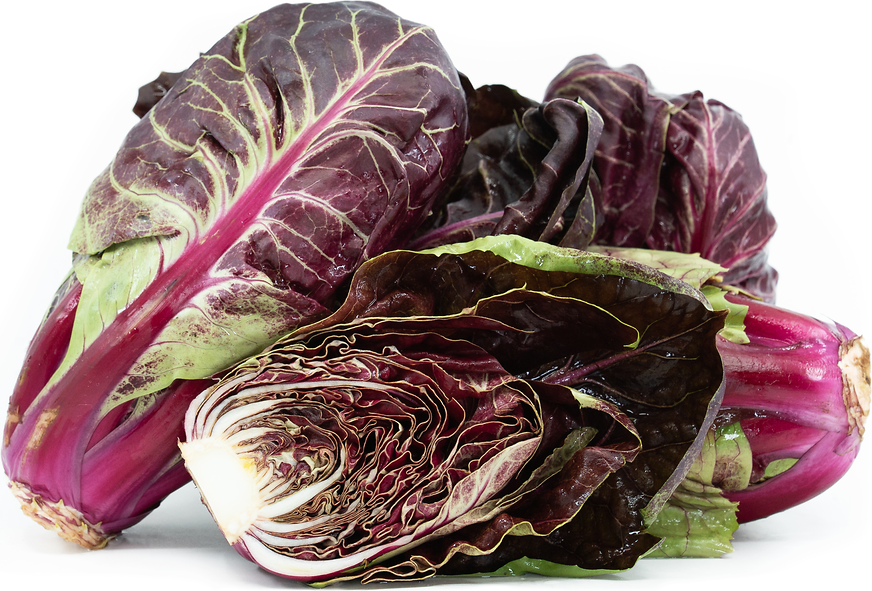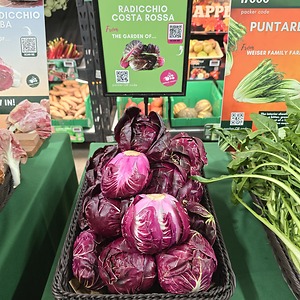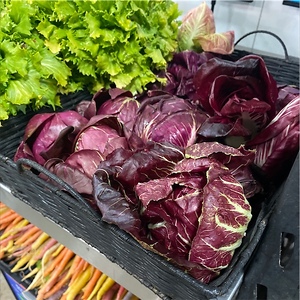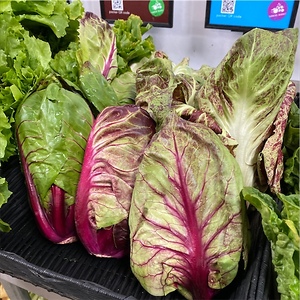


Costa Rossa Radicchio
Estimated Inventory, lb : 0
This item was last sold on : 03/07/25
Description/Taste
Costarossa radicchio is a small to medium-sized varietal, averaging 10 to 12 centimeters in diameter and 12 to 15 centimeters in length, but the size and spread of the heads may vary depending on growing conditions and climate. The heads are compact with a semi-loose structure and have an elongated, oval shape, tapering slightly at each end. Individual leaves have a broad, spade-like appearance with a small point at the top, exhibiting a curved nature, hugging the layers of overlapping leaves. The leaves are also pliable, thick, smooth, and rubbery, showcasing prominent, raised veining and faintly serrated edges. Costarossa radicchio is known for its variegated leaf coloring, combining pale green and dark purple hues. Typically, the outer leaves will showcase more variegation, while the leaves in the center of the head will appear a solid dark red-purple. The variety is also known for its magenta-purple ribs, and this coloring will darken in intensity when exposed to cold weather during cultivation. The vibrant coloring appears on all parts of the rib and extends into the network of veins on the leaf's surface. The ribs are firm, crisp, and crunchy, with a succulent, chewy consistency. Costarossa radicchio has an intensely bitter, tangy taste with vegetal nuances that linger on the palate. After the bitterness dissipates, a subtly sweet, mellow aftertaste emerges amongst the sour tones. When the leaves are paired with ingredients in culinary dishes to balance their bitterness, a refreshing, peppery element can be detected in the leaf's flavor.
Seasons/Availability
Costarossa radicchio is available in the late fall through winter.
Current Facts
Costarossa radicchio, botanically classified as Cichorium intybus, is a rare Italian variety belonging to the Asteraceae family. The pigmented cultivar is a type of Verona radicchio, one of the five most common kinds of radicchio grown in Italy. Verona radicchio is also known as Rosso di Verona, roughly translating to mean "Verona red," a descriptor of the radicchio's coloring and place of origin in Italy. Verona is a city in the region of Veneto in Northern Italy, and Verona radicchio is a popular type known for its bitter flavor, crunchy texture, and dark red coloring. Costarossa translates from Italian to mean "Red Coast" and is a modern Verona-type radicchio naturally bred as a late-harvest variety. The cultivar retains all the qualities favored in Verona radicchio but is distinct for its dark red, pink, to purple ribs. Costarossa is also cold tolerant, maturing in 125 to 130 days, and has extended storage properties without the risk of the leaves changing color. Costarossa is a specialty radicchio type not grown on a large scale. Only a few growers in Italy and the United States currently cultivate the variety, and the fresh greens are offered through select farmer's markets, typically from December through February. Despite their limited availability, Costarossa radicchio is valued by chefs for its robust flavor, brilliant coloring, and versatility in raw and cooked preparations.
Nutritional Value
Costarossa radicchio has not been studied for its nutritional properties. Like other radicchio varieties, the greens are a source of vitamin K to aid the body in faster repairs and improve memory, vitamin C to strengthen the immune system while reducing inflammation, and fiber to regulate the digestive tract. The saturated coloring within the leaves and stems also indicates the presence of anthocyanins. These colored pigments have antioxidant-like properties to protect the cells against the damage caused by free radicals. Beyond antioxidants, radicchio also provides other nutrients, including magnesium, phosphorus, zinc, copper, B vitamins, calcium, vitamin E, iron, and potassium.
Applications
Costarossa radicchio has an intensely bitter flavor suited for fresh and cooked preparations. When serving raw, it is recommended to thinly slice the leaves and ribs to reduce bitterness or to pair them with other strong flavors to balance the taste. The variety can also be torn into smaller pieces and served with creamy dressings and other greens to balance the flavor in salads or thinly sliced and used as a garnish over bruschetta, chocolaty desserts, meat dishes, or grain bowls. Try using portions of the colorful leaves as cups for flavorful dips or seafood, chicken, or tuna salads. The greens can also be mixed with olive oil, nuts, and cheeses for a milder, balanced flavor profile or shredded and used as a pizza topping. Costarossa radicchio can be used in any recipe calling for Verona radicchio. In addition to raw preparations, Costarossa radicchio can be halved and grilled to develop a caramelized consistency, added to soups, stews, and pasta, shredded into grains, or cooked into omelets. The greens can also be sauteed, baked, or braised to impart a mellower taste. In Italy, Verona-type radicchios are commonly baked into sausage lasagna, cooked into frittatas, tossed into pasta, or simmered into risotto. They are also stuffed and baked in meats, pastries, and mushrooms or cooked and served over toast. Costarossa radicchio pairs well with cheeses such as goat, parmesan, and gorgonzola, honey, balsamic vinegar, herbs including basil, mint, and parsley, mushrooms, tomatoes, and nuts such as pine, walnuts, and pecans. Whole, unwashed Costarossa radicchio will keep for 2 to 3 days when wrapped in a paper towel and stored in a plastic bag in the refrigerator's crisper drawer. If the leaves have wilted, they can sometimes be shocked in a bowl of ice water to regain some crispness.
Ethnic/Cultural Info
Costarossa radicchio made its North American debut at the 2020 Chicory Week, held in Portland, Oregon. The Italian variety was selected for introduction into the Pacific Northwest for its intensely pigmented leaves, magenta-fuchsia stems, and cold tolerance, suitable for the region's climate. Boldly Grown Farm in Skagit, Washington, cultivated the variety for Chicory Week, and the annual event attracts chefs, consumers, farmers, and agricultural advocates to celebrate the many types of radicchio. Chicory Week is funded by a grant from the Culinary Breeding Network and Washington State University Food Systems and is inspired by the regional festivals of Italy, each known as a sagra, to bring awareness of the different greens grown in the Pacific Northwest. 2022 was one of the first in-person Chicory Week events since the Covid pandemic and featured speakers, tastings, cooking demonstrations, and educational exhibits to promote the production and consumption of radicchio. Within the week-long festivities, there is a Radicchio Symposium and Sagra del Radicchio, events focused solely on unique varieties such as Costarossa.
Geography/History
Costarossa radicchio was developed by Levantia Seed, a company based in the Veneto region of Italy. Levantia Seed headquarters is located in the heart of the Delta Po Regional Park, an area known for its biodiversity and ideal climate for agriculture within the Porto Viro commune or Veneto. Much of the variety's history is unknown, but Costarossa radicchio is a type of Verona radicchio. Verona radicchio dates back to the mid to late 18th century in farming communities just outside of the city of Verona in Italy. Italian farmers were constantly breeding and improving radicchio varieties for enhanced appearance, flavor, and growth characteristics, and by the early 19th century, Verona radicchio was being sold in local markets throughout Italy. In 2019, Levantia Seed trialed a new type of Verona radicchio in their fields, created from years of selection and traditional crossbreeding. The variety was well-received in the trials, and the company decided to continue to grow it for consumer markets in 2020, naming it Costarossa. Once released, Levantia Seed sent Costarossa radicchio seeds to the Culinary Breeding Network in the United States, and a few growers began offering the variety as a specialty radicchio through local markets, especially in the Pacific Northwest. Today Costarossa radicchio is available in limited quantities through growers and distributors in the United States and Italy and is also offered in seed form through online retailers.











